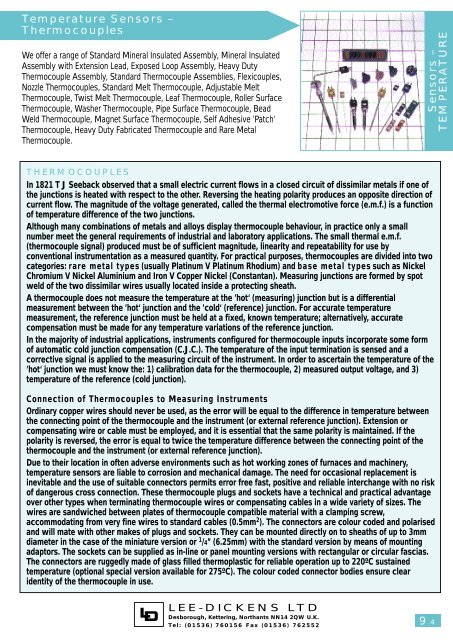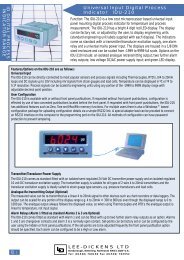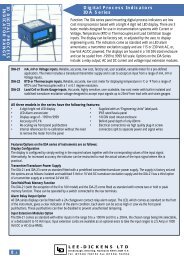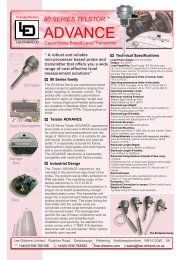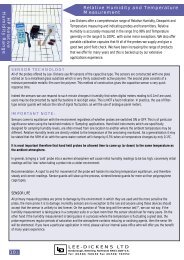Temperature Sensors – Thermocouples Sensors ... - Lee-Dickens Ltd.
Temperature Sensors – Thermocouples Sensors ... - Lee-Dickens Ltd.
Temperature Sensors – Thermocouples Sensors ... - Lee-Dickens Ltd.
You also want an ePaper? Increase the reach of your titles
YUMPU automatically turns print PDFs into web optimized ePapers that Google loves.
<strong>Temperature</strong> <strong>Sensors</strong> –<br />
<strong>Thermocouples</strong><br />
We offer a range of Standard Mineral Insulated Assembly, Mineral Insulated<br />
Assembly with Extension Lead, Exposed Loop Assembly, Heavy Duty<br />
Thermocouple Assembly, Standard Thermocouple Assemblies, Flexicouples,<br />
Nozzle <strong>Thermocouples</strong>, Standard Melt Thermocouple, Adjustable Melt<br />
Thermocouple, Twist Melt Thermocouple, Leaf Thermocouple, Roller Surface<br />
Thermocouple, Washer Thermocouple, Pipe Surface Thermocouple, Bead<br />
Weld Thermocouple, Magnet Surface Thermocouple, Self Adhesive ’Patch‘<br />
Thermocouple, Heavy Duty Fabricated Thermocouple and Rare Metal<br />
Thermocouple.<br />
THERMOCOUPLES<br />
In 1821 T J Seeback observed that a small electric current flows in a closed circuit of dissimilar metals if one of<br />
the junctions is heated with respect to the other. Reversing the heating polarity produces an opposite direction of<br />
current flow. The magnitude of the voltage generated, called the thermal electromotive force (e.m.f.) is a function<br />
of temperature difference of the two junctions.<br />
Although many combinations of metals and alloys display thermocouple behaviour, in practice only a small<br />
number meet the general requirements of industrial and laboratory applications. The small thermal e.m.f.<br />
(thermocouple signal) produced must be of sufficient magnitude, linearity and repeatability for use by<br />
conventional instrumentation as a measured quantity. For practical purposes, thermocouples are divided into two<br />
categories: rare metal types (usually Platinum V Platinum Rhodium) and base metal types such as Nickel<br />
Chromium V Nickel Aluminium and Iron V Copper Nickel (Constantan). Measuring junctions are formed by spot<br />
weld of the two dissimilar wires usually located inside a protecting sheath.<br />
A thermocouple does not measure the temperature at the ’hot‘ (measuring) junction but is a differential<br />
measurement between the ’hot‘ junction and the ’cold‘ (reference) junction. For accurate temperature<br />
measurement, the reference junction must be held at a fixed, known temperature; alternatively, accurate<br />
compensation must be made for any temperature variations of the reference junction.<br />
In the majority of industrial applications, instruments configured for thermocouple inputs incorporate some form<br />
of automatic cold junction compensation (C.J.C.). The temperature of the input termination is sensed and a<br />
corrective signal is applied to the measuring circuit of the instrument. In order to ascertain the temperature of the<br />
’hot‘ junction we must know the: 1) calibration data for the thermocouple, 2) measured output voltage, and 3)<br />
temperature of the reference (cold junction).<br />
Connection of <strong>Thermocouples</strong> to Measuring Instruments<br />
Ordinary copper wires should never be used, as the error will be equal to the difference in temperature between<br />
the connecting point of the thermocouple and the instrument (or external reference junction). Extension or<br />
compensating wire or cable must be employed, and it is essential that the same polarity is maintained. If the<br />
polarity is reversed, the error is equal to twice the temperature difference between the connecting point of the<br />
thermocouple and the instrument (or external reference junction).<br />
Due to their location in often adverse environments such as hot working zones of furnaces and machinery,<br />
temperature sensors are liable to corrosion and mechanical damage. The need for occasional replacement is<br />
inevitable and the use of suitable connectors permits error free fast, positive and reliable interchange with no risk<br />
of dangerous cross connection. These thermocouple plugs and sockets have a technical and practical advantage<br />
over other types when terminating thermocouple wires or compensating cables in a wide variety of sizes. The<br />
wires are sandwiched between plates of thermocouple compatible material with a clamping screw,<br />
accommodating from very fine wires to standard cables (0.5mm 2 ). The connectors are colour coded and polarised<br />
and will mate with other makes of plugs and sockets. They can be mounted directly on to sheaths of up to 3mm<br />
diameter in the case of the miniature version or 1 /4” (6.25mm) with the standard version by means of mounting<br />
adaptors. The sockets can be supplied as in-line or panel mounting versions with rectangular or circular fascias.<br />
The connectors are ruggedly made of glass filled thermoplastic for reliable operation up to 220ºC sustained<br />
temperature (optional special version available for 275ºC). The colour coded connector bodies ensure clear<br />
identity of the thermocouple in use.<br />
LEE-DICKENS LTD<br />
Desborough, Kettering, Northants NN14 2QW U.K.<br />
Tel: (01536) 760156 Fax (01536) 762552<br />
<strong>Sensors</strong> –<br />
TEMPERATURE<br />
9.4
<strong>Sensors</strong> –<br />
TEMPERATURE<br />
9.5<br />
<strong>Temperature</strong> <strong>Sensors</strong> – <strong>Thermocouples</strong><br />
Selecting a thermocouple sensor – we list here things to be considered:<br />
*In-Line Connectors – Plug and Sockets<br />
Standard Plug Socket Miniature Plug Socket<br />
25.3mm<br />
30mm<br />
38mm<br />
in-line socket<br />
*Panel Mounting Connectors – Sockets<br />
*Thermocouple cables: A guide to the selection of wire and cable – insulation – single or multistand<br />
Extension or Compensating Cable? Extension cable uses the same material as the thermocouple whereas<br />
Compensating cable uses material with a similar emf/temperature characteristic over a limited temperature range.<br />
For maximum accuracy extension cables should be used and terminals and connectors should be of the<br />
thermocouple materials to maintain continuity. For details of the international thermocouple connectors, extension<br />
and compensating wires and cables colour codes see page 9.8.<br />
Insulation Thermocouple extension cable can come with a variety of insulation as follows:<br />
Single or Multistrand? The choice is mainly determined by the application (e.g. termination considerations and<br />
internal diameter of associated sheath). Generally, single strand wires are used for hot junctions, and multistrand for<br />
extensions of the thermocouples as being more flexible. The greater the effective conductor diameter, the lower the<br />
value of thermocouple loop resistance; an important consideration with long cable runs.<br />
Both PRTs and <strong>Thermocouples</strong>, with or without extension cables fitted, can have a variety of terminations fitted as follows:<br />
16.5mm<br />
12.5mm 8mm<br />
LEE-DICKENS LTD<br />
Desborough, Kettering, Northants NN14 2QW U.K.<br />
Tel: (01536) 760156 Fax (01536) 762552<br />
21mm<br />
24mm<br />
in-line socket<br />
Standard Round Face Rectangular Face Miniature Round Face Rectangular Face<br />
4mm 28mm<br />
31.5mm<br />
38mm 28mm<br />
19mm<br />
38mm<br />
13mm<br />
fascia version fascia cut-out fascia cut-out<br />
27mm<br />
Material Useable <strong>Temperature</strong> Application Notes<br />
Range<br />
24mm 18-20mm 14mm<br />
23.5mm 17mm<br />
8.5mm<br />
2mm 23mm<br />
fascia version fascia cut-out fascia cut-out<br />
PVC –10ºC to +105ºC Good general purpose insulation for ’light‘ environments. Waterproof and very flexible.<br />
PTFE –75ºC to +250/300ºC Resistant to oils, acids, other adverse agents and fluids. Good mechanical strength and flexibility.<br />
Glass Fibre (Varnished) –60ºC to +350/400ºC Good temperature range but will not prevent the ingress of fluids. Fairly flexible but does not provide<br />
good mechanical protection.<br />
High Temp. Glass Fibre –60ºC to +700ºC Will withstand high temperature up to 700ºC. Will not protect against fluids and physical disturbance.<br />
Ceramic Fibre 0 to +1000ºC Will withstand high temperatures up to 1000ºC. Will not protect against fluids and physical disturbance.<br />
Glass Fibre (Varnished)<br />
Stainless Steel Overbraid<br />
–60ºC to +350/400ºC Good resistance to physical disturbance and high temperature. Will not prevent the ingress of fluids.<br />
A<br />
Base<br />
Wire<br />
10<br />
10<br />
17<br />
B<br />
3.16in<br />
I D Ring<br />
10<br />
10<br />
17<br />
C<br />
2 BA<br />
Spade<br />
12.5<br />
3<br />
18<br />
D<br />
Blade<br />
16.5<br />
8<br />
22<br />
E<br />
4 BA<br />
Spade<br />
7.5<br />
7.5<br />
F<br />
1/4in<br />
Faston<br />
19.5<br />
30<br />
25.3<br />
Standard<br />
Connector<br />
Z<br />
21<br />
16.5<br />
Miniature<br />
Connector<br />
Z
<strong>Temperature</strong> <strong>Sensors</strong> – <strong>Thermocouples</strong><br />
tails 100mm<br />
Replacement element supplied 50mm longer than immersion<br />
depth to allow for insertion into head<br />
50mm<br />
Immersion depth, min. 50mm<br />
Dia.<br />
Dia.<br />
Immersion depth, min. 50mm<br />
ALSO AVAILABLE WITH 4-20mA<br />
TRANSMITTER IN HEAD<br />
Silver soldered Hot Junction<br />
Stainless Steel Tube<br />
Probe<br />
Diameter110oC Probe Length<br />
100mm<br />
19mm AF<br />
probe length<br />
Optional thread<br />
below head<br />
probe length<br />
tails 100mm<br />
probe length<br />
Probe length<br />
Lead Type A<br />
Lead Length<br />
Dia. mm<br />
Dia. mm<br />
82mm<br />
Cable gland<br />
92mm<br />
76.2mm<br />
55mm<br />
12.7mm<br />
6.35mm<br />
1/2" UNF - 20, 1/2" in BSF<br />
or Metric 12 x 1<br />
45o Immersion depth (to be selected)<br />
Dia. mm<br />
10.57 10.67mm<br />
7.80 7.87mm<br />
2.97 3.03mm<br />
88mm<br />
Standard Mineral Insulated Assembly Type: MI (Insulated) ME<br />
(Earthed) –100ºC to +1200ºC Max cold end (pot seal) +100ºC<br />
Available in any combination of thermocouple calibrations (J, K, T, E and N),<br />
sheath length or sheath diameter, (0.5, 1.0, 1.5, 2.0, 3.0, 4.5, 6.0 and<br />
8.0mm). Complete with plain pot seal, (or threaded option), and 100mm<br />
tails or thermocouple connector terminations.<br />
Mineral Insulated Assembly with Extension Lead Type: MI (Insulated)<br />
ME (Earthed) –100ºC to +1200ºC Max cold end (pot seal) +100ºC<br />
The sensor specification is identical to the standard mineral insulated<br />
assembly. However, these units have an additional flexible lead out to suit<br />
the application. Note: J, K, T and E sheath is stainless steel as standard.<br />
Specify if Inconel is required for type K. Type N is supplied with nicrobell B<br />
sheath. A plain stainless steel pot is fitted as standard. Specify if 1/8” BSP<br />
or 8mm ISO pot is required. Locknuts are also available.<br />
Exposed Loop Assembly Type: EX –100ºC to +800ºC Max cold end<br />
+100ºC<br />
Available in thermocouple calibrations (J, K, T and N), and sheath diameter,<br />
(1.0, 1.5, 2.0, 3.0, 4.5, and 6.0mm) this mineral insulated thermocouple<br />
employs an exposed hot junction to achieve the fastest possible thermal<br />
response and sensitivity. As standard the EX is fitted with a standard size male<br />
compensating connector (option miniature). Note: When exposed to<br />
temperatures in excess of 450ºC the sensors seal integrity is compromised.<br />
Heavy Duty Thermocouple Type: HD –100ºC to +1200ºC<br />
This assembly comprises a mineral insulated thermocouple probe<br />
terminating in a weather-proof head and provides for long life even under<br />
rigorous conditions of vibration, abrasion, corrosion and wide temperature<br />
range. A cable gland is fitted in each case. Replacement elements are<br />
available which consist of a probe and bare element tails. Single or dual<br />
element versions are available as standard. Flameproof assemblies and<br />
alternative head types are also available.<br />
Standard <strong>Thermocouples</strong> Type: LS –60ºC to +350ºC<br />
The thermocouple element is protected by a 316 stainless steel tube with a<br />
silver soldered tip as standard or welded as an option. The hot junction is<br />
grounded as standard or optionally insulated. Single or dual element versions<br />
are available and the probes can be straight or formed (bent) as required during<br />
manufacture. An economical and versatile range which is popular for a wide<br />
variety of medium temperature applications, particularly in the plastics industry.<br />
Note: Maximum sensor working temperature is determined by the lead type<br />
selected.<br />
Standard Melt Thermocouple Type: PU, PM or PF 0ºC to +500ºC<br />
Designed to withstand the very high pressures experienced within the<br />
nozzles of plastic extruders and injection moulders, these thermocouples<br />
enable direct measurement of the molten plastic temperature. The probe<br />
element is thermally insulated from the bolt to allow more accurate<br />
measurement. The immersion depth (probe extension beyond the bolt) must<br />
be specified. The probe is terminated in a standard compensating plug as<br />
standard.<br />
LEE-DICKENS LTD<br />
Desborough, Kettering, Northants NN14 2QW U.K.<br />
Tel: (01536) 760156 Fax (01536) 762552<br />
<strong>Sensors</strong> –<br />
TEMPERATURE<br />
9.6
<strong>Sensors</strong> –<br />
TEMPERATURE<br />
9.7<br />
12mm<br />
13"<br />
<strong>Temperature</strong> <strong>Sensors</strong> – <strong>Thermocouples</strong><br />
Bell Spring<br />
100mm<br />
1/4in BSF, or metric<br />
6 x 1.0 thread<br />
Lead Length<br />
6mm clearance (alternative sizes available)<br />
Specify pipe diameter in mm<br />
Lead length<br />
Pipe diameter + 33mm<br />
100mm<br />
Braided Leads<br />
Lead Length<br />
100mm Tails Lead Length<br />
40"<br />
Cable gland<br />
Refractory Sheath<br />
Immersion Length<br />
(max 600mm)<br />
AVAILABLE WITH 4-20mA<br />
TRANSMITTER IN-HEAD<br />
Optional thread<br />
can be fitted<br />
St.Steel or Inconel<br />
support tube<br />
100mm<br />
Lead Length<br />
Braided Leads<br />
Immersion Depth, min. 50mm<br />
Stainless steel<br />
welded end<br />
82mm<br />
Cable gland<br />
105mm<br />
Dia.<br />
92 mm<br />
Nozzle Thermocouple Type: NF or NM –60ºC to +350ºC<br />
The thermocouple element is housed in a stainless steel imperial or metric<br />
bolt for threading directly into the process. The grounded element is brazed<br />
into the nozzle tip allowing it to be threaded in without the leads being<br />
turned. Stainless steel braided leads are fitted as standard.<br />
Washer Thermocouple Type: WR –60ºC to +350ºC<br />
The thermocouple hot junction is located in a washer which has a 6.0mm<br />
clearance hole for bolting to the surface to be monitored. Available in type<br />
T, N, J and K thermocouple versions with various choices of lead out<br />
(7/0.2mm).<br />
Pipe Surface Thermocouple Type: PC –60ºC to +350ºC<br />
The thermocouple hot junction is located on the inside face of the stainless<br />
steel clip; tightening of the clip directly around the pipe thus ensures good<br />
thermal contact between the pipe surface and the sensor. Combinations of<br />
different calibration type and clip diameter make this thermocouple<br />
suitable for a wide range of applications.<br />
Bead Weld Thermocouple Type: BW –60ºC to +350ºC<br />
This sensor is the most simple type of thermocouple and is therefore<br />
inexpensive. The thermocouple junction is formed directly on the end of a length<br />
of thermocouple extension cable. The exposed junction has a small thermal<br />
mass and therefore will respond quickly to temperature change. It can be<br />
attached to a surface using self adhesive pads (supplied separately) used for<br />
gas temperatures or in the case of the PVC or PTFE version immersed in fluids.<br />
Self Adhesive ’Patch‘ Thermocouple Type: PATCH –50ºC to +150ºC<br />
A thermocouple junction is housed in a flexible silicon rubber ’patch‘. The<br />
proximity of the element to the self adhesive face of the patch ensures<br />
good surface temperature sensing. Available with an extensive choice of<br />
leadouts.<br />
Heavy Duty Fabricated Thermocouple Type: LM –100ºC to +500ºC<br />
The assembly comprises a 316 stainless steel sheath and a die cast<br />
aluminium weatherproof head. This low cost assembly combines high<br />
sensitivity and fast response with rugged construction and utilizes<br />
components rated for sustained high temperature operation. Supplied with<br />
an insulated hot junction as standard. A range of optional male brass<br />
threads can be fitted below the head for process mounting.<br />
Rare Metal Thermocouple Type: PRV 0ºC to +2000ºC<br />
Platinum v Platinum Rhodium thermocouples housed in a refractory<br />
aluminium oxide sheath with a weatherproof connecting head and<br />
stainless steel or inconel support tube. A choice of type R (PtvPt13%Rh)<br />
and type S (PtvPt10%Rh) thermocouples are available. The standard<br />
refractory sheath (60% Aluminium Oxide) provides good protection in a<br />
wide range of applications and permits continuous operation at 1400ºC.<br />
Details of other types mentioned in the header section can be obtained by application to our internal sales department.<br />
LEE-DICKENS LTD<br />
Desborough, Kettering, Northants NN14 2QW U.K.<br />
Tel: (01536) 760156 Fax (01536) 762552
<strong>Temperature</strong> <strong>Sensors</strong> – <strong>Thermocouples</strong><br />
THERMOCOUPLE CONNECTORS, EXTENSION AND COMPENSATING<br />
WIRES AND CABLES<br />
INTERNATIONAL COLOUR CODES<br />
The British standard colour code for thermocouple cables BS1843:1952 has been replaced by BS4937 part<br />
30:1993 (IEC584-3:1989 modified). This change came into effect in January 1994 and BS1843 will be phased out<br />
by December 1998. <strong>Lee</strong>-<strong>Dickens</strong> will also phase in the use of the new standard. Cables and connectors are<br />
available in the new colours now.<br />
CODE CONDUCTORS<br />
(Operating ranges vary with<br />
wire size and application)<br />
E<br />
J<br />
K<br />
N<br />
T<br />
RCA<br />
SCA<br />
KCB<br />
+ / –<br />
NICKEL<br />
CHROMIUM/CONSTANTAN<br />
–200°C to 850°C<br />
(Nickel Chromium/Copper-Nickel,<br />
Chromel/Constantan, T1/Advance,<br />
NiCr/Constantan)<br />
IRON */CONSTANTAN<br />
0°C to 850°C<br />
(Iron/Copper-Nickel Fe/Konst,<br />
Iron/Advance, Fe/Constantan, I/C)<br />
NICKEL CHROMIUM<br />
NICKEL * ALUMINIUM<br />
–200°C to 1100°C<br />
(NC/NA, Chromel/Alumel) C/A,<br />
T1/T2, NiCr/Ni,NiAL)<br />
NICROSIL/NISIL<br />
–200°C to 1300°C<br />
COPPER/CONSTANTAN<br />
–200°C to 400°C<br />
(Copper/Copper-Nickel, Cu/Con,<br />
Copper/Advance)<br />
COPPER/COPPER NICKEL<br />
Compensating for Platinum 10% or<br />
13% Rhodium/Platinum (Codes S<br />
and R respectively, over Range 0-<br />
50°C) (Copper/Cupronic, Cu/CuNi,<br />
Copper/No. 11 Alloy)<br />
COPPER/CONSTANTAN<br />
(LOW NICKEL)<br />
(Cu/Constantan)<br />
Compensating for “K” over<br />
Range 0–80°C<br />
(Cu/Constantan)<br />
BRITISH<br />
BS 1843:1952<br />
MAGNETIC () ALTERNATIVE & TRADE NAMES<br />
EXISTING COLOUR CODES<br />
Extension & Compensating Leads<br />
+<br />
–<br />
+<br />
–<br />
+<br />
–<br />
+<br />
–<br />
+<br />
–<br />
+<br />
–<br />
+<br />
–<br />
AMERICAN<br />
ANSI/MC 96.1<br />
+<br />
–<br />
+<br />
–<br />
+<br />
–<br />
+<br />
–<br />
+<br />
–<br />
+<br />
–<br />
+<br />
–<br />
For thermocouple<br />
connectors, body colours<br />
are as outer sheath<br />
colours above<br />
GERMAN<br />
DIN<br />
+<br />
–<br />
+<br />
–<br />
+<br />
–<br />
+<br />
–<br />
+<br />
–<br />
For thermocouple<br />
connectors, body colours<br />
are as outer sheath<br />
colours above<br />
LEE-DICKENS LTD<br />
Desborough, Kettering, Northants NN14 2QW U.K.<br />
Tel: (01536) 760156 Fax (01536) 762552<br />
NEW<br />
IEC584-3: 1989, mod<br />
BS4937, Part 30. 1993<br />
+<br />
–<br />
+<br />
–<br />
+<br />
–<br />
+<br />
–<br />
+<br />
–<br />
+<br />
–<br />
+<br />
–<br />
For thermocouple<br />
connectors, body colours<br />
are as outer sheath<br />
colours above<br />
EX<br />
JX<br />
KX<br />
NX<br />
NC<br />
TX<br />
RCA<br />
SCA<br />
KCB<br />
THERMOCOUPLE CONNECTORS<br />
New colour coded connectors will be marked IEC and will have a grey body with a clearly visible colour coded<br />
area (with exceptions of the facia/panels sockets). This is to prevent any confusion regarding the use of the new<br />
and old colour coded connectors.<br />
<strong>Sensors</strong> –<br />
TEMPERATURE<br />
9.8


